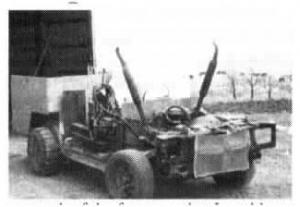Go-Cart Wood Splitter
 ✖  |
"It's small and mobile. Lets me cut a tree down in the woods and drive right up to it. I spent less than $500 to build it," says Leon Burkholder, Memphis, Mo., who turned a 1980 Chevrolet car into a self-propelled "go-cart" wood splitter.
Burkholder stripped away the body and shortened the frame and drive shaft 2 ft., keeping the 305 cu. in. V-8 gas engine, automatic transmission, and tires. He turned the exhaust manifolds upside down and pointed a pair of mufflers straight up in the air to keep hot exhaust pipes from starting a fire in the woods. He mounted the car's gas tank on back of the frame and mounted a 4-ft. by 5-ft. plywood box above it. He removed the passenger seat and put a home-built wood splitter in its place that's made from a 5-ft. long H-beam equipped with a 24-in. hydraulic cylinder. The hydraulic pump, reservoir, and control valve for the splitter are off an old combine. A balancer wheel taken from the combine's engine is used to belt-drive the pump.
"It looks a little crude but it works great," says Burkholder. "I had been using a splitting maul and hauling the wood with a pickup or trailer which wasn't nearly as convenient. The box on this rig hauls about one third as much wood as a pickup. If I did it again I'd use a 4-WD car for better traction. I have to put chains on the rear tires. Also, I wouldn't cut off as much of the frame so that I could use a cylinder with a longer stroke. I use a hand throttle to speed up or slow down the engine and the control valve to operate the cylinder. I used cable off an old riding lawn mower to connect the throttle with the car's accelerator. The car had cruise control so I was able to use extra linkage at the accelerator. When the box is full of wood, I shut off the hand throttle and use the foot accelerator to drive out of the woods"
Burkholder used plywood to cover the car frame and mounted a sheet of plywood in front of the steering wheel to make a firewall. A section of wire screen in front of the rig keeps tree limbs out of the radiator.
The splitter's end plate was made from 5/8-in. thick steel. A piece of angled steel was used to make the splitter wedge.
Contact: FARM SHOW Followup, Leon Burkholder, Rt. 2, Box 154, Memphis, Mo. 63555 (ph 816 328-6658).

Click here to download page story appeared in.
Click here to read entire issue
Go-Cart Wood Splitter WOODLOT EQUIPMENT Wood Splitters 18-5-7 "It's small and mobile. Lets me cut a tree down in the woods and drive right up to it. I spent less than $500 to build it," says Leon Burkholder, Memphis, Mo., who turned a 1980 Chevrolet car into a self-propelled "go-cart" wood splitter.
Burkholder stripped away the body and shortened the frame and drive shaft 2 ft., keeping the 305 cu. in. V-8 gas engine, automatic transmission, and tires. He turned the exhaust manifolds upside down and pointed a pair of mufflers straight up in the air to keep hot exhaust pipes from starting a fire in the woods. He mounted the car's gas tank on back of the frame and mounted a 4-ft. by 5-ft. plywood box above it. He removed the passenger seat and put a home-built wood splitter in its place that's made from a 5-ft. long H-beam equipped with a 24-in. hydraulic cylinder. The hydraulic pump, reservoir, and control valve for the splitter are off an old combine. A balancer wheel taken from the combine's engine is used to belt-drive the pump.
"It looks a little crude but it works great," says Burkholder. "I had been using a splitting maul and hauling the wood with a pickup or trailer which wasn't nearly as convenient. The box on this rig hauls about one third as much wood as a pickup. If I did it again I'd use a 4-WD car for better traction. I have to put chains on the rear tires. Also, I wouldn't cut off as much of the frame so that I could use a cylinder with a longer stroke. I use a hand throttle to speed up or slow down the engine and the control valve to operate the cylinder. I used cable off an old riding lawn mower to connect the throttle with the car's accelerator. The car had cruise control so I was able to use extra linkage at the accelerator. When the box is full of wood, I shut off the hand throttle and use the foot accelerator to drive out of the woods"
Burkholder used plywood to cover the car frame and mounted a sheet of plywood in front of the steering wheel to make a firewall. A section of wire screen in front of the rig keeps tree limbs out of the radiator.
The splitter's end plate was made from 5/8-in. thick steel. A piece of angled steel was used to make the splitter wedge.
Contact: FARM SHOW Followup, Leon Burkholder, Rt. 2, Box 154, Memphis, Mo. 63555 (ph 816 328-6658).
To read the rest of this story, download this issue below or click
here to register with your account number.







